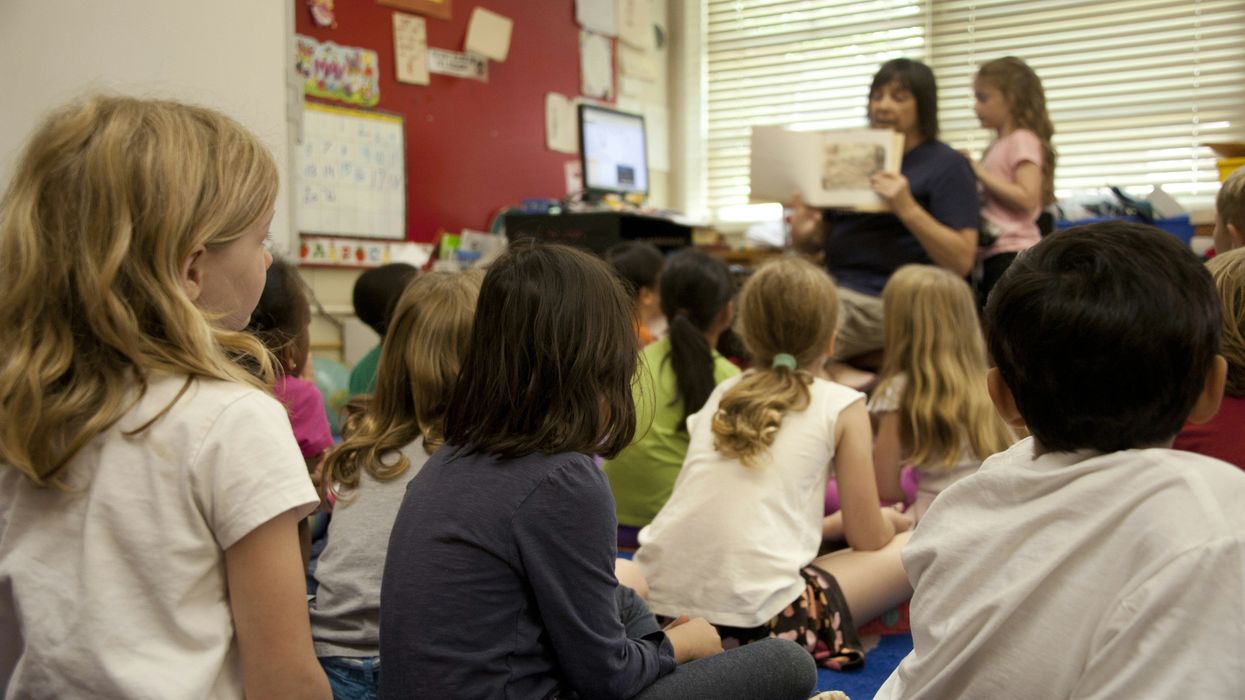
Photo by Pedro Lima on Unsplash
March 17, 2025
The Texas Tribune
Testifying this month against bills that would put more Christianity in Texas public schools, the Rev. Jody Harrison invoked the violent persecution of her Baptist forefathers by fellow Christians in colonial America.
Harrison hoped the history lesson would remind Texas senators of Baptists’ strong support for church-state separations, and that weakening those protections would hurt people of all faiths.
Instead, she was rebuked.
“The Baptist doctrine is Christ-centered,” Sen. Donna Campbell, R-New Braunfels, responded sharply. “Its purpose is not to go around trying to defend this or that. It is to be a disciple and a witness for Christ. That includes the Ten Commandments. That’s prayer in schools. It is not a fight for separation between church and state.”
Harrison was not allowed to reply, but in an interview said she was stunned that a lawmaker would question a core part of her faith. The exchange, she said, perfectly encapsulated why she has fought to preserve church-state separations — the same religious protections that Campbell said are a distraction from bills that might bring school kids to Christ.
“It was a wake up call,” she said. “I don’t think people — even many churches — realize that this is going on right now, and that is alarming.”
/https://static.texastribune.org/media/files/c7b32325d70298a704c90e9383c9763d/0311%20Anti-Communism%20LW%20TT%2002.jpg)
State Sen. Donna Campbell, R-New Braunfels, listens as Rafael Cruz, father of U.S. Sen. Ted Cruz, speaks to the Senate Committee on Education K-16 on March 11, 2025. Credit: Lorianne Willett/
Efforts by the Christian Right to put more of their religion in public schools are not new. But the tone of those debates in Texas has shifted this session, with bill supporters and some lawmakers openly arguing that such legislation is crucial to combating dropping church participation rates and what they say is a directly related decline in American morality.
Last month, a Texas Senate education committee advanced two bills that would require the Ten Commandments to be displayed in public classrooms and allow school districts to set aside optional prayer time during school hours. And last week, that committee also heard testimony on a bill to mandate that schools teach an anti-communist curriculum — which supporters said is crucial to reaffirming that America is a Christian nation.
Throughout those hearings, lawmakers and bill supporters frequently said that church-state separation is a myth meant to obscure America’s true, Christian roots. They argued that many of America’s ills are the natural consequence of removing Biblical morality from classrooms. And they framed their legislation as an antidote to decreasing church attendance, communism or eternal hellfire.
"To realize that only 25% of our kids in schools today have been in a church is absolutely horrific and something that we all need to work on to address,” said Sen. Tan Parker, R-Flower Mound, repeating a statistic offered by one bill supporter during testimony. “That should make everybody listening absolutely scared to death," he added.
Such statements have struck even longtime scholars and observers of the Religious Right as setting a new, more strident tone after years in which terms like “religious freedom” were the norm. Many in the movement had avoided explicitly centering Christianity in bills because doing so could prompt court challenges and discrimination complaints.
The shift, experts said, reflects a Religious Right emboldened by recent U.S. Supreme Court decisions, the second Trump administration and the broader normalization of Christian nationalism in the GOP.
“Christian nationalist leaders think they've been handed the keys to the kingdom,” said Mark Chancey, a religious studies professor at Southern Methodist University who focuses on movements to put the Bible in schools. “Now they're trying to unlock as
Testifying this month against bills that would put more Christianity in Texas public schools, the Rev. Jody Harrison invoked the violent persecution of her Baptist forefathers by fellow Christians in colonial America.
Harrison hoped the history lesson would remind Texas senators of Baptists’ strong support for church-state separations, and that weakening those protections would hurt people of all faiths.
Instead, she was rebuked.
“The Baptist doctrine is Christ-centered,” Sen. Donna Campbell, R-New Braunfels, responded sharply. “Its purpose is not to go around trying to defend this or that. It is to be a disciple and a witness for Christ. That includes the Ten Commandments. That’s prayer in schools. It is not a fight for separation between church and state.”
Harrison was not allowed to reply, but in an interview said she was stunned that a lawmaker would question a core part of her faith. The exchange, she said, perfectly encapsulated why she has fought to preserve church-state separations — the same religious protections that Campbell said are a distraction from bills that might bring school kids to Christ.
“It was a wake up call,” she said. “I don’t think people — even many churches — realize that this is going on right now, and that is alarming.”
/https://static.texastribune.org/media/files/c7b32325d70298a704c90e9383c9763d/0311%20Anti-Communism%20LW%20TT%2002.jpg)
State Sen. Donna Campbell, R-New Braunfels, listens as Rafael Cruz, father of U.S. Sen. Ted Cruz, speaks to the Senate Committee on Education K-16 on March 11, 2025. Credit: Lorianne Willett/
Efforts by the Christian Right to put more of their religion in public schools are not new. But the tone of those debates in Texas has shifted this session, with bill supporters and some lawmakers openly arguing that such legislation is crucial to combating dropping church participation rates and what they say is a directly related decline in American morality.
Last month, a Texas Senate education committee advanced two bills that would require the Ten Commandments to be displayed in public classrooms and allow school districts to set aside optional prayer time during school hours. And last week, that committee also heard testimony on a bill to mandate that schools teach an anti-communist curriculum — which supporters said is crucial to reaffirming that America is a Christian nation.
Throughout those hearings, lawmakers and bill supporters frequently said that church-state separation is a myth meant to obscure America’s true, Christian roots. They argued that many of America’s ills are the natural consequence of removing Biblical morality from classrooms. And they framed their legislation as an antidote to decreasing church attendance, communism or eternal hellfire.
"To realize that only 25% of our kids in schools today have been in a church is absolutely horrific and something that we all need to work on to address,” said Sen. Tan Parker, R-Flower Mound, repeating a statistic offered by one bill supporter during testimony. “That should make everybody listening absolutely scared to death," he added.
Such statements have struck even longtime scholars and observers of the Religious Right as setting a new, more strident tone after years in which terms like “religious freedom” were the norm. Many in the movement had avoided explicitly centering Christianity in bills because doing so could prompt court challenges and discrimination complaints.
The shift, experts said, reflects a Religious Right emboldened by recent U.S. Supreme Court decisions, the second Trump administration and the broader normalization of Christian nationalism in the GOP.
“Christian nationalist leaders think they've been handed the keys to the kingdom,” said Mark Chancey, a religious studies professor at Southern Methodist University who focuses on movements to put the Bible in schools. “Now they're trying to unlock as
many locks as they can.”
The growing influence
Recent polling from the Public Religion and Research Institute found that, of all Americans, about 10% adhere to Christian nationalism and 20% sympathize with aspects of it. Experts say that, despite accounting for a small segment of the broader country, Christian nationalists and their allies have been able to incrementally accumulate power through a long-term political strategy and a well of deep-pocketed donors.
In Texas, the Christian Right’s rising influence has coincided with the state GOP’s alignment with two West Texas oil billionaires, Tim Dunn and Farris Wilks, who have given tens of millions of dollars to push their far-right religious and social views. And groups like Project Blitz, a coalition of Christian groups with deep Texas ties, have used that long-term approach to steadily normalize their views and chip away at church-state separation without drawing widespread opposition.
/https://static.texastribune.org/media/files/6989d6cdf78919afc61ac3bc651f9d96/Wilks%20and%20Dunn%20TT%2001.jpg)
From left: West Texas billionaires Farris Wilks and Tim Dunn. Credit: Courtesy Ronald W. Erdrich/Abilene Reporter-News|Brett Buchanan for The Texas Tribune
“Part of their legislative strategy is to be additive,” said Amanda Tyler, executive director of the Baptist Joint Committee For Religious Freedom, which advocates for a strong church-state wall. “The idea is that you start lawmakers out with what appear to be lower-stakes legislation, and then once they take votes on that, they will move to more and more extreme versions of the legislation.”
“What we're seeing now is that strategy really coming to bear in Texas,” she added.
In 2010, the State Board of Education approved a sweeping curriculum overhaul in order to weed out what it called “liberal bias.” With advice from prominent evangelicals such as David Barton, a Project Blitz leader and self-described “amateur historian” who has popularized the idea that church-state separation is a “false doctrine,” conservative board members framed the move as a way to reaffirm “that this was a nation founded under God.”
In 2022, the Texas Legislature approved a law that required classrooms to display “In God We Trust” signs that were donated by Patriot Mobile, a self-described Christian nationalist cellphone company that also funds school board candidates. The law quickly drew controversy — at one Dallas-area school district, the board declined to also display donated “In God We Trust” signs that were in Arabic, saying it already had enough for all its buildings.
In 2023, state lawmakers allowed school districts to replace mental health counselors with untrained religious chaplains, overriding a proposed amendment that would have barred them from evangelizing to students. Ahead of the vote, The Texas Tribune reported that a main backer of the bill had run an organization that, until a few months prior, was open about using classrooms as a way to recruit children to Christianity. Barton also testified in favor of the bill.
By 2024, the theories espoused by Barton and his allies were mainstream in the Texas GOP. Prominent figures — including Lt. Gov. Dan Patrick, Texas GOP Chair Abraham George and numerous state senators — have called church-state separation a “myth.” And at the state party’s convention that year, lawmakers framed themselves as engaged in an existential struggle with communists, socialists and others trying to indoctrinate children; delegates called for the state to require instruction on the Bible; and state education board Chair Aaaron Kinsey vowed in a speech to fight for “these three-letter words: G-O-D, G-O-P and U-S-A.”
A few weeks later, state education leaders proposed new curriculum that paired grade-school teachings with lessons on the Bible and other religious texts. The curriculum was approved late last year despite concerns by religious historians and other experts who said it whitewashed the role that many white Christians played in opposing Civil Rights, upholding slavery and persecuting religious minorities, including Baptists and other fellow believers, during the country’s founding period.
The 2025 legislative session began with some Republican lawmakers calling for “spiritual warfare” against political opponents, and leading worship inside the Capitol to ward off demonic spirits that they believe control the legislature. In addition to the Ten Commandments and school prayer bills, state senators have also approved sweeping legislation that would allow taxpayer money to be directed to religious and other private schools.
Tyler, the Baptist leader and church-state wall advocate, said the last 15 years in Texas show how successful Religious Right groups can be in steadily mainstreaming their political views and advancing their agenda.
“We have seen, over several years, a definite strategy to target public schools,” she said. “Now they have become bolder and have been emboldened, and are being more explicit about their aims.”
/https://static.texastribune.org/media/files/20d69ceed7203fce52196a673573f411/Amanda%20Tyler%20TTE%20JS%20TT%2001.jpg)
Amanda Tyler, executive director of the Baptist Joint Committee For Religious Freedom, speaks at The Texas Tribune Festival in Austin on Sept. 22, 2023. Credit: Julius Shieh/The Texas Tribune
The new rhetoric
For decades, David Brockman has closely monitored the rise of Christian nationalism in Texas for Rice University's Baker Institute for Public Policy, where he is a non-resident scholar. A few years ago, he said, he wanted to quantify how many adherents or sympathizers worked in the Texas Legislature by analyzing their comments and speeches for tell-tale signs of Christian nationalist rhetoric. Even then, he said, it was difficult to find many concrete examples of the ideology, or of bills that explicitly privileged Christianity.
But that’s changed.
“What they were doing instead was either carving out exceptions for ‘sincerely-held religious beliefs’ or protecting religion overall,” Brockman said. “Now, it’s a new landscape for them.”
Central to that shift has been a series of recent U.S. Supreme Court decisions, including 2022’s Kennedy v. Bremerton School District. In that case, the court ruled with a high school football coach whose employer, a public school, asked that he stop leading prayers at midfield after games. In a 6-2 decision, the court found that the coach’s prayers were within his First Amendment rights and that his actions did not amount to government support of religion. The ruling neutered the so-called Lemon Test, which for decades had been used by courts to determine if a law or practice amounted to an unconstitutional government act establishing or preferring a religion.
Conservative Christians have taken the 2022 ruling as a greenlight to put more Christianity into public schools, arguing that things such as the Ten Commandments are the basis for American law and governance, and therefore have educational value. This session, lawmakers and their supporters have also argued that such legislation is imperative to reverse what they say is a decadeslong moral decline.
“I think our kids are just crying out for moral clarity,” said Sen. Phil King, a Weatherford Republican who authored the Ten Commandments bill. “I think they are crying out for a shared heritage.”
Other lawmakers have explicitly said that they have a duty to bring kids to Christ.
“There is eternal life,” said Campbell, the senator who rebuked Rev. Harrison earlier this month. “And if we don’t expose or introduce our children and others to that, when they die they’ll have one birth and two deaths. Because they will know nothing about the afterlife, the eternity with God. But exposing them or introducing them to Ten Commandments, prayer – it asks other questions and they then have a choice in their future: Two births and one death.”
Last week, a Texas Senate panel heard testimony on a bill that would require public schools to adopt anti-communist curriculum. On its face, the bill does not seek to put more Christianity in classrooms. But supporters argued that the bill is crucial to combating godless ideologies that they say have crept into American education and undermined the nation’s true, Christian heritage.
Such fears have been a driving force of Christian Right movements since the 1950s, when Christians, believing their faith a key bulwark against Red influence, successfully lobbied to add “under God” to the pledge of allegiance and to make “In God We Trust” the national motto.
Those fears are still pronounced today. Last week, lawmakers heard testimony from Rafael Cruz, a pastor who is the father of U.S. Sen. Ted Cruz’s and an adherent of Christian dominionism, which argues Christians must dominate society to usher in the End Times. Cruz repeatedly argued that America – and thus, Christianity — are under threat from communist and socialist forces who seek to indoctrinate children through Critical Race Theory, diversity initiatives and other things that Republicans have targeted in recent years.
“In many instances our classrooms are failing us, because they’re following an agenda,” Cruz said. “It is not our agenda. It is a communist agenda that has, like tentacles, immersed itself into our education system. So we need to retrieve our educational system from that evil agenda.”
Throughout his testimony, Cruz took aim at a litany of things that he said are quietly advancing communist influence in America, be it atheism, evolution, college professors or campus protesters who “don’t like it here” and should be deported. Fighting that menace, he said, required lawmakers to legislate Christianity into public schools across the nation.
“America is a Christian country,” said Cruz, who was invited by lawmakers to testify. “And we need to build upon that foundation, because if we build that foundation in our children, everything else will fall into place.”
/https://static.texastribune.org/media/files/0e379788e5f6596b3692ee3d986405de/0311%20Anti-Communism%20LW%20TT%2017.jpg)
Rafael Cruz, father of U.S. Sen. Ted Cruz, after testifying before the Senate Committee on Education K-16 on March 11, 2025. Credit: Lorianne Willett/The Texas Tribune
Texas has for years been an incubator for Christian Right policies that are exported to other states or codified into federal law by courts. Lawmakers and their supporters have said they are confident that the current slate of Christian-centric bills will pass and then survive expected court challenges — though some legal experts are less sure.
Rev. Harrison, meanwhile, said she has frequently ruminated on her recent exchange with Sen. Campbell, and what it portends for Americans who are not conservative Christians. To her, it’s so much more than a debate about schools or the church-state wall.
“I believe we preach the gospel of Jesus Christ most powerfully without words, and for me, that means to follow the example of the way of Jesus,” she said. “Often the most powerful example we can set for others in preaching the gospel as Christians is by our actions. We are called to love one another, and that means speaking up for those whose voices are not heard and or are silenced.”
Disclosure: Rice University's Baker Institute for Public Policy and Southern Methodist University have been financial supporters of The Texas Tribune, a nonprofit, nonpartisan news organization that is funded in part by donations from members, foundations and corporate sponsors. Financial supporters play no role in the Tribune's journalism. Find a complete list of them here.
This article originally appeared in The Texas Tribune at https://www.texastribune.org/2025/03/17/texas-christian-nationalists-legislature-school/.
The Texas Tribune is a member-supported, nonpartisan newsroom informing and engaging Texans on state politics and policy. Learn more at texastribune.org









.jpg)



